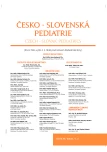Hyponatremia – serious complication of nephrotic syndrome
Authors:
S. Szórádová; M. Chocholová; Ľ. Podracká
Authors‘ workplace:
Detská klinika LFUK a NÚDCH, Bratislava, Slovensko
Published in:
Čes-slov Pediat 2020; 75 (2): 103-107.
Category:
Case Report
Overview
Hyponatremia (s-Na <135 mmol/L) is the most common electrolyte abnormality in hospitalized children. A decrease in serum sodium concentration leads to neurological symptomatology and in severe cases is responsible for significant morbidity and mortality. Dreaded and potentially fatal complication of a rapid hyponatremia correction is the osmotic demyelination syndrome. Important risk factors for hyponatremia include nephrotic syndrome. Only anecdotal case reports of hyponatremic encephalopathy associated with nephrotic syndrome are described in the literature. The authors present a rare case report of a severe symptomatic hyponatremia (s-Na 111 mmol/L, relative urinary potassium excretion 92%) in a 6-year-old boy with relapse of nephrotic syndrome and transient renal dysfunction (AKI pRIFLE).
The treatment of severe hyponatremia with edema is demanding and requires considerable clinical experience. According to the classical hypothesis, in the pathophysiology of nephrotic edema large proteinuria and hypoalbuminemia can lead to intravascular hypovolemia and the kidneys retain sodium and water via compensatory mechanism in an attempt to maintain adequate circulatory volume („underfill hypothesis”). On the other hand, in glomerulonephritis the primary intrarenal retention of sodium and water applies to edema formation („overfill” hypothesis). The main task for a clinician is to recognize the basic mechanism of edema and to determine the correct treatment. In practice, relative urinary potassium excretion in the initial urine sample might be helpful. Excretion index higher than 60% suggests an intravascular hypovolemia.
Conclusion: Hyponatremia is a serious complication of relapse of nephrotic syndrome. The treatment of such complication should be managed by skilled clinician. The goal of the correction is a slow and gradual increase of serum sodium concentrations by a maximum of 12 mmol/L/24 hours in hyponatremic encephalopathy.
Keywords:
hypervolemic hyponatremia – Edema – nephrotic syndrome – underfill and overfill hypothesis
Sources
1. Hasegawa H, Okubo S, Ikezumi Y, et al. Hyponatremia due to an excess of arginine vasopressin is common in children with febrile disease. Pediatr Nephrol 2009; 24 : 507.
2. Don M, Valerio G, Korppi M, Canciani M. Hyponatremia in pediatric community acquired pneumonia. Pediatr Nephrol 2008; 23 : 2247.
3. Zieg J. Hyponatrémie u dětí. In: Lebl J, et al. Poruchy vodní a elektrolytové rovnováhy u dětí. 1. vyd. Praha: Galén, 2019 : 37-46. ISBN 978-80-7492-405-7.
4. Ellis D. Pathophysiology, evaluation, and management of edema in childhood nephrotic syndrome. Front Pediatr 2016; 3 : 111.
5. Cadnapaphornchai MA, Tkachenko O, Shchekochikhin D, et al. The nephrotic syndrome: pathogenesis and treatment of edema formation and secondary complications. Pediatr Nephrol 2014; 29 : 1159.
6. Siddall CE, Radhakrishnan J. The pathophysiology of edema formation in the nephrotic syndrome. Kidney Int 2012; 82 : 635–642.
7. Sterns RH, Riggs JE, Schochet SS Jr. Osmotic demyelination syndrome following correction of hyponatremia. N Engl J Med 1986; 314 : 1535.
8. Hurley JK. Symptomatic hyponatremia in nephrotic syndrome. Am J Dis Child 1980; 134 (2): 204–206.
9. Tullu MS, Deshmukh I, Muranjan MN, et al. Extrapontine myelinolysis in a child with nephrotic syndrome. Pediatr Neurol 2010; 43 : 139–141.
10. Filippatos TD, Liamis G, Christopoulou F, Elisaf MS. Ten common pitfalls in the evaluation of patients with hyponatremia. Eur J Intern Med 2016; 29 : 22–25.
11. Kapur G, Valentini RP, Imam AA, Mattoo TK. Treatment of severe edema in children with nephrotic syndrome with diuretics alone – a prospective study. Clin J Am Soc Nephrol 2009; 4 : 907–913.
12. Fliser D, Zurbrüggen I, Mutschler E, et al. Coadministration of albumin and furosemide in patients with the nephrotic syndrome. Kidney Int 1999; 55 : 629.
13. Hodson E. The management of idiopathic nephrotic syndrome in children. Paediatr Drugs 2003; 5 : 335–349.
14. Haws RM, Baum M. Efficacy of albumin and diuretic therapy in children with nephrotic syndrome. Pediatrics 1993; 91 : 1142–1146.
15. Wang SJ, Tsau ZK, Lu FL, Chen CH. Hypovolemia and hypovolemic shock in children with nephrotic syndrome. Acta Paediatr Taiwan 2000; 41 : 179–189.
16. Royal Children‘s Hospital Melbourne Australia. Clinical Practice Guideline on Hyponatremia. Dostupné na: www.rch.org.au/clinicalguide/index.cfm.
Labels
Neonatology Paediatrics General practitioner for children and adolescentsArticle was published in
Czech-Slovak Pediatrics

2020 Issue 2
- What Effect Can Be Expected from Limosilactobacillus reuteri in Mucositis and Peri-Implantitis?
- The Importance of Limosilactobacillus reuteri in Administration to Diabetics with Gingivitis
Most read in this issue
- Foreign bodies in the swallowing pathways in children
- Successful ultrasound-guided percutaneous ethanol injection therapy of thyroid cysts in adolescents
- Treatment of thrombosis in newborns and infants
- Aspiration of the foreign bodies in children – case reports
